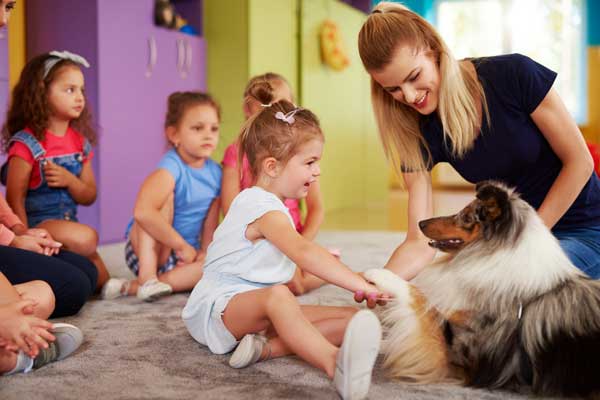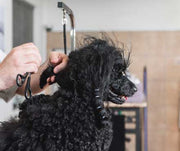Can My Dog Become a Therapy Dog?

Therapy dogs have a somewhat significant task, and they are also known to carry quite a heavy load on their shoulders.
Often trained to provide affection, support, and comfort to people, these four-legged therapists are commonly found in health centers, hospitals, nursing homes, retirement homes, libraries, schools, disaster areas, and hospice centers. Because of their contribution, their demand and popularity have increased over time.
Highly considered emotional support animals, these comfort dogs are responsible for supporting a person's mental health. How do they do it, you ask?
They provide attention with their sweet demeanors and unconditional love to people who find comfort in their presence. People diagnosed with mental health challenges and psychiatric disorders have been proven to be receptive to the benefits of therapy dogs.
Which then begs the question – can my dog become a therapy dog?
We're glad you asked! In this feature, we will tackle whether any pup is capable of providing the special care that some people need.
Let's get started!
THE POSITIVE EFFECTS OF DOGS
Usually, petting a dog can be a natural stress reliever for pet parents in general. This is why after a hard day's work, dog owners typically reach out to their pets, and in return, their dogs anxiously await their owners' return home.
Additionally, certain studies have also shown that aside from being great stress relievers, dogs are also responsible for increasing happy hormones in humans, making them great companions for specific individuals going through something quite heavy or severe. Animal-assisted therapy can also be the right solution for people with anxiety or for those individuals who are merely seeking companionship.
CHARACTERISTICS OF THERAPY DOGS
Since they will be primarily interacting with patients, therapy dogs need to be calm, well-mannered, friendly, and easy-going. They are also usually highly trainable, well-groomed, and obedient. Since they are everything aforementioned and more, patients can also expect behavior reflective of a high degree of training.

Many people tend to confuse therapy dogs with service dogs. While there are several similarities, it is essential to be aware of their distinction.
Service dogs serve as supporters for a wide array of disabilities. As a result, service dogs are allowed in all public and private establishments and businesses, so long as they do not violate any safety protocols.
CAN ANY DOG BE A THERAPY DOG?
Of course, dogs do have a reputation as being man's best friend, but that doesn't indicate that any dog can become a therapy dog by default.
Dogs of a friendly breed can be ideal therapy dog candidates. Some of the notable breeds are Labradors, St. Bernards, and Golden Retrievers. It is important to note that therapy dogs must already be adults, must enjoy exposure to new and different people regularly, and should be very affectionate to strangers.
In addition, therapy dogs must be patient, confident, reliable, and at ease in nearly every situation. These traits make them qualified to become candidates as therapy dogs.
THERAPY DOG CERTIFICATION
Before our four-legged friends can pass as therapy dogs, they are required to undergo the certification process.
It helps to know that a variety of procedures are needed for a dog to become certified by a national organization, such as The Alliance of Therapy Dogs. Many organizations require your dog to pass the Canine Good Citizen (CGC) test for obedience. Others may even require a therapy-specific test to see if your dog will fit the part. Most of them will consider temperament, skills, and the dog's relationship with humans.
Although you can train your dog yourself, it helps to seek help from professionals. This is especially true if you are serious about developing your dog's abilities. If not an option, you can always start with basic training, such as positive reinforcement. It might even be helpful to research specific organizations and communities that you may want to join to help you and your dog's journey.
THERAPY DOG MATERIAL
Should you be interested in turning your dog into a therapy dog, you need to be an observant owner. Your dog should not have a strong reaction to noise or sudden movements. Instead, your dog should react calmly to anything that causes these noises and movements and tend to have a cool and calm demeanor. In addition, a majority of therapy dog organizations may require dogs to be well-groomed and healthy.
Also, others require that dogs be up to date on all of their vaccinations, so be sure to double-check your dog's vaccination records.
THE WRAP-UP
There can never be too many therapy animals in this world. Besides the fact that you get to help others, it can also be a fun means of bonding between you and your pet!
Previous article

Next article

Related posts
View all-

Keep Your Pets Safe During the Holidays
The holiday season brings joy, festivities, and a break from the usual routine. While you're enjoying the celebrations, it's important to remember that the holidays can present unique challenges for our furry family members. The new sights, sounds, and people can be overwhelming, and common festive items can pose unexpected risks.
Read Article -

Holiday Gifts for Every Pet Personality: The Ultimate Guide
The holiday season is finally here, and for many of us, that means finding the perfect presents for the ones we love most—our pets. Whether they are a steadfast dog who never leaves your side or an independent cat who graces you with their presence on their own terms, our pets are cherished members of the family. They deserve to celebrate right alongside us, stocking stuffers and all.
Read Article -

How to Keep Your Pet Calm During Thanksgiving
Thanksgiving is a time for family, friends, and food, but for our pets, the holiday can be overwhelming. The sudden change in routine, unfamiliar faces and scents, and increased noise can trigger significant stress. Understanding why your pet might feel anxious is the first step toward creating a peaceful holiday experience for everyone, including your furry family members. This guide offers calming tips for pets and practical solutions to ensure your dog or cat feels safe and secure during the festivities.
Read Article



